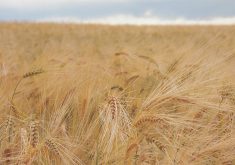(The author is a Reuters market analyst. The opinions expressed are his own.)
By Gavin Maguire
CHICAGO Feb 25 – Grain analysts broke out in a chorus of grumbles last week as the U.S. Department of Agriculture released its first major set of assumptions and forecasts pertaining to the upcoming U.S. crop growing season in its annual Outlook Forum.
Grain analysts always find much to disagree with in these early-season forecasts of prices, planted area and production of top crops. But this year analysts seemed to take particular offense at the USDA’s corn yield forecast of 165.3 bushels an acre, which would be a new record, and more than 10 percent higher than the average for the past five years.
Read Also

U.S. grains: Soy hits 17-month high, corn to four-month top as trade braces for U.S. data
Chicago Board of Trade soybean futures rose on Thursday to their highest in nearly 17 months as traders awaited a U.S. government crop report that was expected to lower yield estimates, while also bracing for the resumption of export data to give clues on Chinese buying.
Yet central to USDA’s forecasting seems to be a meaningful cutback in corn plantings on less-productive land, which tends to drag down the average. So the apparently fanciful average yield projection may not be as unrealistic as it appears.
GROUNDSWELL
Total U.S. corn production increased by 40 percent since 2000 to just shy of 14 billion bushels in 2013, driven largely by a close to 20 percent increase in planted area.
A rapid acceleration in corn demand, stemming mainly from the large-scale ramp up in corn-based ethanol production, was the main catalyst behind this push into corn, which also brought about steep price gains from 2006 onwards.
But while this escalation in corn production over the past decade or so may appear to have been orderly at a national level, it has been somewhat more uneven at a state and regional level, with a disproportionately large swell in planted area and production in states outside the traditional ‘Corn Belt.’
Historically, the top five corn growing states of Iowa, Illinois, Nebraska, Minnesota and Indiana accounted for the lion’s share of national corn output. From 1990 to 2005 those five states produced an average of 65 percent of the country’s total between them.
But since 2005, a large jump in corn plantings outside those core states reduced the overall share of production out of the “Top 5”. In 2013, their collective contribution dropped to less than 60 percent for the first time on record.
Most of those additional acres were located in states such as Kansas, South Dakota and North Dakota, which between them added close to 5 million acres to total U.S. corn area since 2005. States such as Arkansas, North Carolina, Tennessee and Texas also saw double-digit gains in corn planted area over the same period, highlighting how widespread the increase in corn’s area footprint has been.
But while this broad swell in corn plantings has been a major reason why overall corn production has been able to increase so impressively in recent years, the fact that so much production is taking place on land outside the heart of the Midwest is also a reason why national corn yields have struggled to record similar growth rates over the same period.
FRINGE STATE YIELD DRAG
While total U.S. corn production climbed by more than 25 percent since 2005 off a 16.6 percent increase in planted area, the national corn yield increased by less than 7.5 percent over the same period.
Challenging weather conditions have limited productivity gains, especially in 2010 and 2012 when historically hostile growing weather devastated much of the Midwest.
But lower grade soils are also to blame for much of the persistent underperformance of corn yields at a national level.
Corn yields in the “Top 5” states have averaged 10 bushels per acre above the national average for the past five years, while the mean yield for the largest corn growers on the fringes of the Midwest, Kansas, South Dakota and North Dakota, is more than 25 bushels an acre below the national average.
This significant underperformance of “Fringe state” yields relative to core Corn State yields has dragged heavily on the national average, especially in recent years when those non-core states have contributed a historically high proportion of corn planted area.
But the likelihood for a reduction in corn plantings on those fringe acres in 2014 is also a major reason why this year’s average corn yield has the potential to pop well above the recent average should growing conditions prove broadly friendly.
And growers across those fringe areas are the most likely to cut back on corn production in 2014 as breakeven prices in those areas are typically higher than those at the heart of the Corn Belt due to broadly higher production costs associated with greater chemical and fertilizer requirements.
Should those growers aggressively cut back plantings on their least productive land, the proportion of production stemming from those areas will also decline. This will allow the output from corn’s traditional stronghold at the heart of the Midwest to place a greater role in determining the average yield, which may well surprise to the upside in 2014 if unburdened by large swaths of lower-tier acres.














